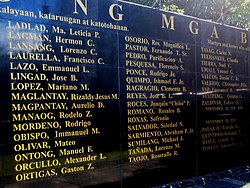Atty. Hermon Lagman (February 12, 1945 - disappeared May 11, 1977) was a Filipino labor lawyer best known for his role in the Philippine labor sector's resistance against the Marcos dictatorship, which resulted in his forced disappearance in 1977.[1][2] In 1992, he was among the first batch of 65 Martial Law era martyrs to be honored by having their names engraved on the Wall of Remembrance at the Philippines Bantayog ng mga Bayani memorial.
Hermon Lagman | |
|---|---|
 Detail of the Wall of Remembrance at the Bantayog ng mga Bayani, showing names from the first batch of Bantayog Honorees, including that of Hermon Lagman. | |
| Born | December 10, 1948 |
| Alma mater | University of the Philippines Diliman |
| Occupation | labor lawyer |
| Relatives | Filemon Lagman (brother); Edcel Lagman (brother); Edcel Greco Lagman (nephew) |
Education
editLagman took up an undergraduate degree and later studied law at the University of the Philippines Diliman, where he was senior editor of the Philippine Collegian and later became editor-in-chief of the Law Register, the official paper of the law students at the University of the Philippines.[1][3][4]
Career
editUpon passing the Philippine bar exams in 1971, Lagman immediately got into labor law, volunteering his services to the Citizens’ Legal Aid Society in the Philippines and eventually becoming a founding member of the Free Legal Assistance Group.[1]
When Ferdinand Marcos declared Martial Law in 1972, Lagman was among the first to be arrested,[3] and remained a political detainee for two months. He would later be briefly arrested again in 1976.[1]
As a lawyer, Lagman is best remembered for being the legal counsel to many of the labor unions which spearheaded the 1975 La Tondeña Distillery strike,[1] which was one of the first major open acts of resistance against the Marcos dictatorship and an important turning point for the period.[5]
Disappearance
editLagman was accompanied by his associate Victor Reyes while traveling from Quezon City to a meeting in Pasay City on May 11, 1977, when they disappeared. Efforts to find the two in Marcos' various detention centers and military camps produced no results, but Lagman's mother received anonymous call which informed her that the two had been abducted. After that, there was no further news about the location of Lagman or Reyes' bodies.[1][4] The two are among the 640 individuals who remain missing after having disappeared during the Marcos regime.[3]
Family
editLagman's parents Pedro Eduardo Lagman Jr. (February 14, 1919 – March 9, 2006) and Cecilia Castellar-Lagman (February 1, 1920 – August 13, 2012) who are both buried at Loyola Memorial Park. He was the brother of Filemon "Popoy" Lagman, the founder of the Partido ng Manggagawa, Alex Boncayao Brigade, and who was assassinated in 2001. Another brother, Edcel Lagman, is a Filipino human rights lawyer who served as Minority Floor Leader of the House of Representatives of the Philippines from July 2010 to January 2012. His nephew, Edcel Greco Lagman, is the incumbent Governor of Albay.[6]
References
edit- ^ a b c d e f Malay, Carolina S.; Rodriguez, Ma Cristina V. (2016). Ang mamatay nang dahil sa 'yo: Heroes and martyrs of the Filipino people in the struggle against dictatorship, 1972-1986. volume 2. Ermita, Manila, Philippines: National Historical Commission of the Philippines. ISBN 978-971-538-304-2.
- ^ Cull, H. A., & Allen, D. W. (1987). Human Rights Advocacy in the Philippines. Australian Section of the International Commission of Jurists.
- ^ a b c Gavilan, Jodesz (2022-09-03). "'We deserve the truth': Families of desaparecidos continue to fight for justice". RAPPLER. Retrieved 2023-12-02.
- ^ a b Cepeda, Cody (2016-08-13). "Reopening wounds: The Martial Law victims and the families left behind". The LaSallian. Retrieved 2023-12-02.
- ^ Pimentel, Benjamin (December 30, 2014). "10 anniversaries Filipinos should remember in 2015". Inquirer. Retrieved May 5, 2020.
- ^ Dematera, Cet. "New Albay governor, vice governor assume post". Philstar.com. Retrieved 2022-12-13.